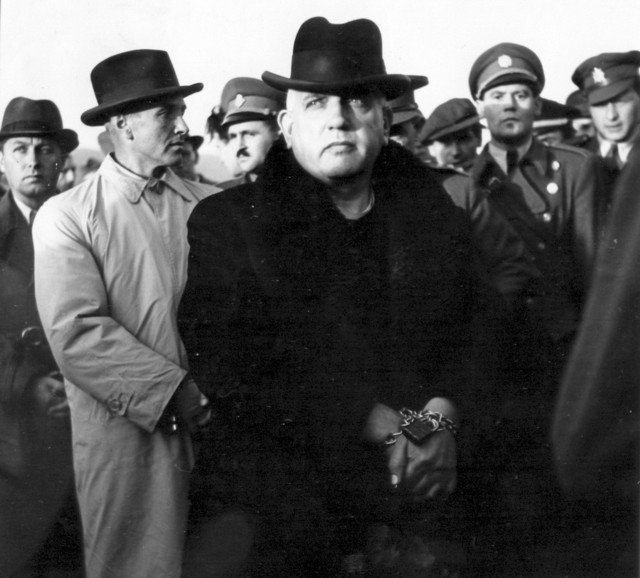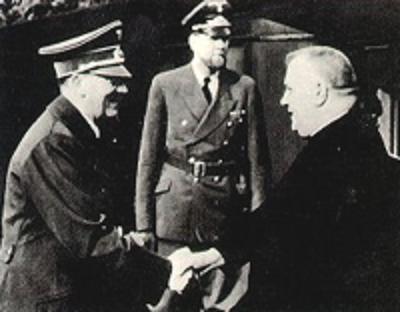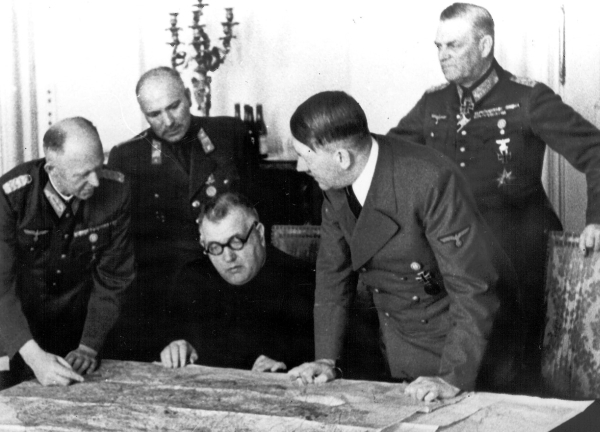<Back to Index>
- Physician Rudolf Ludwig Karl Virchow, 1821
- Painter Allan Ramsay, 1713
- President of the Slovak State Jozef Tiso, 1887
PAGE SPONSOR
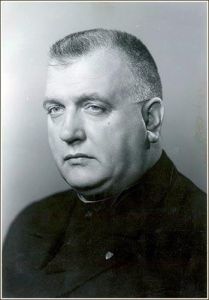
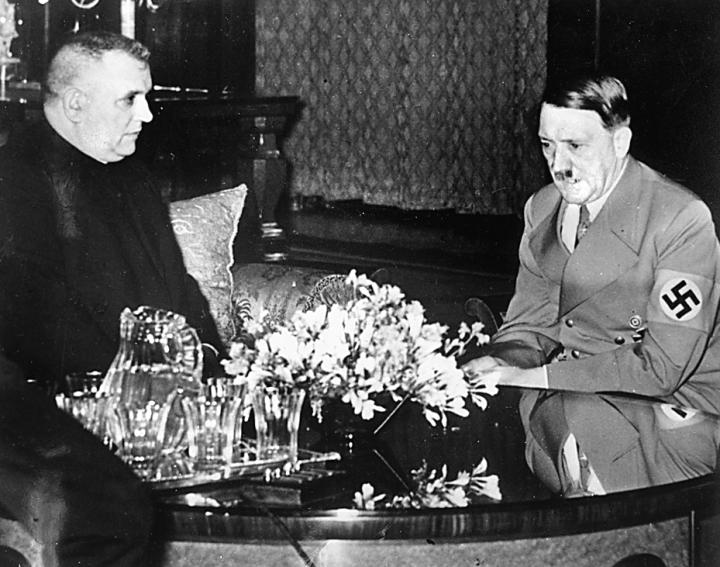
Jozef Tiso (13 October 1887 – 18 April 1947) was a Slovak politician of the SPP and priest, who became the clerofascist leader of the Slovak State, a satellite state of Nazi Germany existing between 1939 and 1945. After the end of World War II, Tiso was convicted and hanged for his activities in support of nazism and treason.
Tiso was born in Nagybiccse (today's Bytča) to Slovak parents in Austria - Hungary. The Bishop of Nitra (Nyitra), Imre Bende, offered Tiso a chance to study for the priesthood, and, in 1911, Tiso graduated from the prestigious Pázmáneum in Vienna. His early ministry was spent as an assistant priest in three parishes in today's Slovakia. After brief frontline service as a field curate in World War I, he was appointed as the Spiritual Director of the Nitra seminary by Bende's successor, Vilmos Batthyány. Tiso was also active at this time as a school teacher and journalist. His articles for the local paper would later be controversial because of their strong support for the Hungarian war cause.
With
the collapse of Austria - Hungary and the creation of Czechoslovakia in
1918, Tiso suddenly embraced politics as a career, at the same time
declaring himself in public as a Slovak. Within a few weeks, he had
joined the Slovak People's Party.
From 1921 to 1923, he served as the secretary to the new Slovak bishop
of Nitra, Karol Kmeťko. During the same period, political agitation
earned Tiso two convictions for incitement, the second of which
resulted in a short incarceration. Displeased, Kmeťko dropped him as
secretary in 1923, but retained him as a Professor of Theology. In
1924, Tiso left Nitra to become parish priest and then dean of
Bánovce nad Bebravou. His dedication to this parish would become
legendary, and he would remain its very active priest even during his
presidency. Tiso became one of the leaders of the Slovak People's Party (otherwise known as the Ľudáks), which had been founded by Father Andrej Hlinka in 1913, while Austria - Hungary still ruled Slovakia. The party's interwar platform demanded the autonomy of
Slovakia within a Czechoslovak framework. After 1925, the Ľudáks
were the largest party in Slovakia. They were one of two explicitly
Slovak parties in Slovakia, the others either representing national minorities or
structuring themselves as Czechoslovak. Although Tiso seemed destined
in the late 1920s to soon succeed Hlinka, he spent the 1930s instead
competing for Hlinka's mantle with party radicals, most notably Karol Sidor. When Hlinka died in 1938, Tiso emerged only as de facto leader of the party. He, however, quickly consolidated his control of the party, becoming its undisputed chairman in fall 1939. Tiso
first ran for parliament in 1920. Although the electoral results from
his district were bright spots in what was otherwise a disappointing
election for the Ľudáks, the party did not reward him with a
legislative seat. Tiso, however, easily claimed one in the 1925
election, which also resulted in a breakthrough victory for the party.
Until 1938, he was a fixture in the Czechoslovak parliament in Prague.
From 1927 to 1929, in a failed attempt to integrate the Ľudáks
into the Czechoslovak polity, he also served as the Czechoslovak
Minister of Health and Physical Education. Adolf Hitler's Germany annexed the Sudetenland (the German part of Czechoslovakia) and the Czechoslovak president Edvard Beneš fled the country in October 1938. During the chaos which resulted, the Slovaks (who had lacked any form of autonomy within
Czechoslovakia) declared their autonomy within Czechoslovakia and Tiso,
as leader of the Slovak People's Party, became (until 9 March 1939) the premier of the autonomous Slovak region. Hungary,
having never really accepted the separation of Slovakia from its
control in 1918, took advantage of the situation and managed to persuade Germany and Italy to force Slovakia to let Hungarian troops occupy one third of Slovak territory in November 1938, by the so-called Vienna Award (Vienna Arbitration). In the light of this situation, all Czech or Slovak political parties in Slovakia (except for the Communists)
voluntarily joined forces and set up the "Hlinka's Slovak People's
Party - Party of Slovak National Unity" in November 1938, which created
the basis for the future authoritarian regime in Slovakia. (The same
happened in the Czech part of the country two weeks later for Czech
parties.) In January 1939, the Slovak government officially prohibited
all parties apart from the Party of Slovak National Unity, the
"Deutsche Partei" (a party of Germans in Slovakia) and the "Unified
Hungarian Party" (a party of Hungarians in Slovakia). From
February 1939, representatives of Germany - planning to occupy the
Czech part and basically not interested in Slovakia - started to
officially persuade Slovak politicians to declare the independence of
Slovakia. On 9 March 1939, Czech troops occupied Slovakia and Tiso lost his post of Prime Minister. On 13 March 1939, Adolf Hitler lost
his patience. He invited Tiso - as the deposed prime minister - to
Berlin, and personally forced him to immediately (as he said "in a
flash") declare the independence of Slovakia under German "protection",
otherwise Germany would allow Hungary (and partly Poland) to annex the remaining territory of Slovakia. Under these circumstances, Tiso spoke by phone to the Czechoslovak president Emil Hácha and to the then Prime Minister of Slovakia, Karol Sidor,
and they agreed to convene the Slovak parliament the next day and let
it decide. On March 14, the Slovak parliament unanimously declared the
independence of Slovakia, and on March 15, Germany invaded the
remaining Czech lands - exactly according to German plans. Tiso
served as the Prime Minister of independent Slovakia from 14 March 1939
until 26 October 1939. On 26 October he became President of Slovakia
(separate from the Prime Ministerial office). On October 1, 1939 he
officially became the president of the Slovak People's Party. According
to the pro-Nazi nationalist fashion, from 1942 he was self-styled Vodca "Leader", an imitation in the national language of Führer. The "independence" of Slovakia remained largely illusory in the sense that Slovakia was a German puppet state.
The Slovak People's Party functioned as almost the sole legal political
organisation in Slovakia. The Party under Tiso's leadership aligned
itself with Nazi policy on anti-Semitic legislation
in Slovakia. This was no hard task, given Hlinka's policy of a
"Slovakia for the Slovaks", a line vehemently adhered to by Jozef Tiso.
The respective main act was the so-called Jewish Code. Under the
anti-Semitic Jewish Code, Jews in Slovakia could not own any real
estate or luxury goods, were excluded from public jobs and free
occupations, could not participate in sport or cultural events, were
excluded from secondary schools and universities, and were required to
wear the star of David in public. Tiso himself - like many people in
Central Europe at that time - had definite anti-Semitic views
(as some of his own letters from the end of World War II suggest). In
general, opinions differ widely on his role in the Jewish deportations
from Slovakia, but it is known that he adhered to the Nazi line to a
considerable extent. The Slovak Parliament accepted a bill (may 1942)
unanimously deciding the deportation of the Jews. It may be interesting
to note that the only voice (vote) disagreeing came from the
representative of the Hungarian minority in Slovakia (Eszterhazy). Some
sources prefer the view that Tiso supported the deportations tacitly;
other sources point out that the first deportations had to take place
secretly behind his back due to his "personal opposition". As to the
then Slovak government, however, documents concerning the holocaust in
Slovakia (such as E.Niznansky et al. (eds.), Holokaust na Slovensku, vols. 1-5. Bratislava: NMS/ZNO, 2001 - 2004)
prove that the Slovak government consentingly cooperated with the Nazis
and even somewhat helped coordinate the deportations. In fact, Hitler
praised the policy concerning the Jews of Slovakia in a meeting with
Tiso in the Klessheim Castle in Salzburg (Ostmark) on 22 April 1942. The
deportations of Jews from Slovakia started in March 1942. "By the end
of June 1942, some 52,000 Slovak Jews had been deported, mainly to
Auschwitz and to their death. Then, however, the deportations slowed to
a standstill. The intervention of the Vatican, followed by the bribing
of Slovak officials upon the initiative of a group of local Jews
["Working Group"] did eventually play a role... That bribing the
Slovaks contributed to a halt in the deportations for two years is most
likely...". The
deportations were stopped - despite heavy opposition from Germany,
which demanded their resumption - in October 1942 by Slovaks, when it
became clear that Nazi Germany had not "only" abused the Slovakian Jews
as forced labour workers but had also executed many of them in death
camps, and when public protests arose as well as pressure from the Holy See to
stop the deportations of Jewish civilians. Slovakia became the first
state in the Nazi sphere to stop deportations of Jews, but some 58,000
Jews (75% of Slovak Jewry) had already suffered deportation, mostly to Auschwitz,
of whom only a minority survived. Between October 1942 and October
1944, an independent Slovakia even served as a safe last resort for
Jews suffering persecution in Nazi-occupied neighbouring countries, such as annexed Austria, the Protectorate of Bohemia and Moravia, Poland and occupied Ukraine. Jewish deportations were resumed by German occupation authorities in October 1944 after the Soviet army reached the Slovak border and the Slovak National Uprising took
place. As a result of the Uprising and the approach of the Soviet
forces, Nazi Germany decided to occupy all of Slovakia. Although the
Germans allowed Tiso to remain in office, under their occupation his
presidency was relegated to a mostly titular role as Slovakia lost
whatever de facto independence
it still had. During the 1944 - 1945 German occupation, another 13,500
Jews were deported and 5,000 imprisoned. Some were murdered in Slovakia
itself, in particular at Kremnicka and Nemecka.
Tiso
lost all remnants of power when the Soviet Army conquered the last
parts of western Slovakia in April 1945. He was sentenced for "state treason, treason of the Slovak National Uprising and collaboration with Nazism". On 15 April 1947, the National court (Národný súd) sentenced him to death. President Edvard Beneš declined
to grant a reprieve, despite Tiso's popularity among the Slovaks and
the threat of a rift between the Czech dominated government and the
Slovak minority. Wearing his clerical outfit, Msgr. Jozef Tiso was hanged in Bratislava on 18 April 1947. The Czechoslovak government buried him secretly to avoid having his grave become a shrine.
